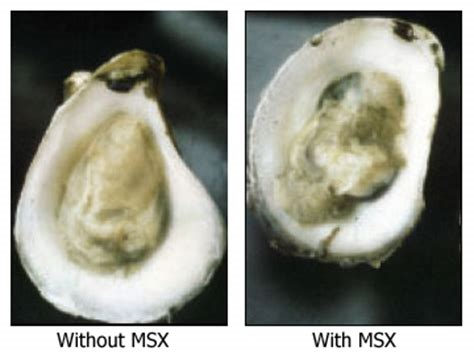|
Eastern Oysters
were once abundant in Barnegat Bay.
|
|
Oysters
Anatomy
Lifecycle
What Happened
Oyster Diseases
|
|
Eastern Oyster
Crassostrea virginica |
|
Once plentiful in
Barnegat Bay, the Eastern oyster had serious
problems with two diseases
MSX and Dermo |
|
|
|
MSX refers
to a disease of oysters caused by the protozoan
organism Haplosporidium
nelsoni.
Haplosporidium
nelsoni, was originally given the acronym “MSX”
because it was observed as a Multinucleated
Sphere with unknown affinity (“X”) |
|
Oyster production
in Chesapeake and Delaware bays has been
severely depressed since the appearance of
H. nelsoni in the late 1950s. |
|
Geographical
distribution
Infected oysters are found along the east
coast of North America from Nova Scotia, Canada
to Florida, USA. |
|
H. nelsoni
cells usually appear first in gill tissue,
indicating that the infective stage is water
borne
Effects of the
disease include decreased condition (meat
quality), reduced reproductive
capacity, and mortality |
|
|
|
Image to the left
is a microscopic view of Haplosporidium nelsoni
|
|

To the right is an
oyster not infected and one that is infected |
|
Infections of
H. nelsoni are rare at
salinities below 10
ppt and intensify above 15 ppt
Cooler water
temperatures also restrict growth. |
|
Selective
breeding has been successful in producing
highly resistant strains and the development
of resistance through natural selection has been
reported in some wild populations subjected to
heavy infection pressure.
Management
strategies include maintaining oysters at
reduced salinities (< 15 ppt) as long as
possible. |
|
|
|
Dermo
Perkinsus marinus |
|
Dermo disease was
first identified as the cause of extensive
oyster mortalities nearly fifty ago |
|
It was originally
thought to be a fungus and was named
Dermocystidium marinum.
Even though
subsequent research led to its reclassification
as a protozoan parasite Perkinsus marinus
in 1978, the disease is still commonly referred
to as “Dermo.” |
|
Dermo is is
characterized by the degradation of oyster
tissue . .
The image on the
left is a healthy oyster
The image on the
right is infected with Dermo |
|
Today P.
marinus is prevalent throughout the warm
waters of the Gulf of Mexico and southeastern U.
S. In recent years its range has extended as far
north as southern Maine, in conjunction with
high winter temperatures |
|
P. marinus
is highly infectious, capable of
spreading rapidly throughout a growing area. The
disease is transmitted directly from infected to
uninfected oysters.
A decrease in
growth is usually noted prior to mortality,
which is typically between 40%
and 90% after two to three years of exposure. |
|
|
|
|
